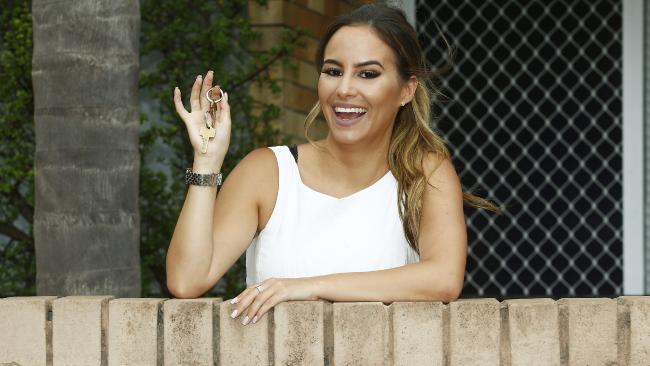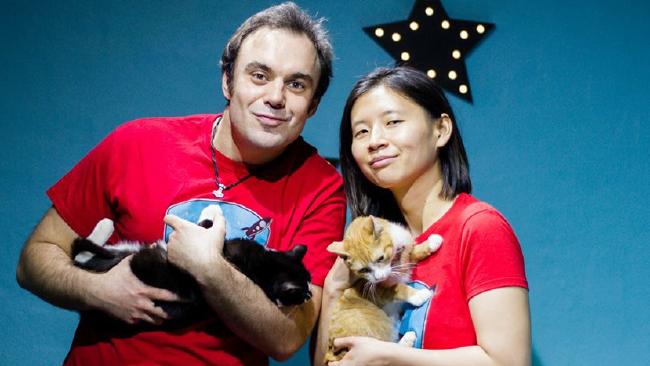IF YOU live in a capital city, you can be excused for thinking real estate prices have jumped the shark.
Sydney’s median house price is well over a $1 million, and Melbourne isn’t far behind. So what does it take for a young person to break into the market?
We spoke to two professional young women about their vastly different experiences.
SAVINGS, GOOD INCOME BUT INELIGIBLE FOR FINANCE
Wenee Yap is a 30-year-old part-time law academic, author and successful entrepreneur. She is also the co-founder of Sydney’s first cat cafe Catmosphere and currently rents an inner-city studio apartment in Sydney with her partner, Thomas Derricott.
“I have $200,000+ in savings and I earn $60,000-$90,000 a year, depending on client work, business and teaching load,” she tells news.com.au. “I’d simply like to own the place I live in. I’ve been trying to buy even the smallest shoebox, but banks don’t give you a mortgage for shoebox studios, so you need to have cash upfront.”
And while Yap says she’d prefer to buy an apartment in the city or on its fringe to avoid commuting, she says she’s not really that fussy. “I’m looking for a one-bedroom apartment in the city or the city fringe and it doesn’t need to be the best place on the planet.”
Despite her earning capacity and impressive savings, Yap says her current employment situation is an issue for the banks who, she believes, are too rigid in their perceptions of ‘financial eligibility’.
“I earn as much now as I did working fulltime but explaining multiple sources of income to banks, the kind that would, I hope, make Robert Kiyosaki proud, is quite challenging,” she says. “I find banks to be dismissive and unhelpful, both in residential lending and business lending.
“Personally, I feel my efforts and savings are best directed towards business … you deliver what people need, create jobs along the way, and if you can, make the world a little bit better.”
THE MORTGAGE BROKER’S REALITY CHECK
Ben Anson from Legend Finance is a mortgage broker of 28 years experience and says right now property investment, in Sydney, in particular, is certainly tough for the renting, average incoming earning 30-something trying to buy their first property.
“For the average young couple to be renting in Sydney and paying $400-$450 per week in rent and saving for a deposit is very difficult unless they forego eating out, holidays, drinks with friends, that kind of thing,” he says.
Anson says the biggest difficultly for young people trying to get on the property ladder isn’t necessarily the sacrifices required in saving for a deposit but rather the prohibitive costs of stamp duty.
“For someone to buy a $600,000 property, they can save the five per cent deposit, which is $30,000, but to then be told they have to save another $32,000 for stamp duty, that tends to be the straw that breaks the camel’s back.”

And just so we’re clear what we’re talking about, this is what $600K buys you in Sydney. A tiny studio in Darlinghurst. Picture: Realestate.com.au Source:Supplied
Anson says in Yap’s situation, her eligibility for bank finance may be limited by the type and size of the property she’s looking at as well as its specific location. “You can’t buy too small an apartment … as there are only one or two lenders that will lend for a small studio under 50 square metres,” Anson says.
“Then it becomes ‘postcode-driven’ or ‘predicated on the postcode’ and there are a number of postcodes — and even building blocks — in Sydney that banks won’t lend to, and yet the average prospective buyer wouldn’t know that.”
KATIE’S SUCCESS STORY
Katie King, 24, achieved a bachelor of business at university and is currently working fulltime in a promotions role in Sydney. She rents a townhouse in Matraville with her partner while renting out her own two investment properties, located in Sydney’s inner-west suburbs.
She says her goal is to grow her investment portfolio to $5 million before she turns 30. “I plan to continue to purchase properties that I perceive to be undervalued with the aim of using equity to continue my purchases,” she says.

Katie King, 24, has two investment properties already and is in the process of buying her third. Picture: John Appleyard Source:News Corp Australia
King started saving for her first property deposit when she was still in high school. “I worked as a part-time receptionist for a real estate agency at 17 and I believe that was the catalyst for my interest in investment property,” she says. “There were often a lot of units on the market in the area that were considerably more affordable than other neighbouring suburbs.”
King took advantage of government grants available at the time of her first purchase while also saving for a deposit by living at home with her parents, investing in the stock market and working as much as possible while studying at university. Then, using the equity from her first property, which increased by $100,000 after just one year, she went on to purchase her second investment property.
She says investing in property takes quite a bit of sacrifice, strict saving and planning. “The earlier you start, the sooner you will be able to get your foot onto the property ladder,” she says. “I didn’t just wake up one day and have all of the funds available, I had to plan for this and it took me four years before I had all my ducks in a row to even make the first step.”
So what’s King’s advice to other young Aussies trying to get on the property ladder? “Our generation is all about now, now, now, when in actual fact buying a property is one of the biggest financial decisions you can make in your lifetime,” she says.
“I think a lot of people become unstuck when they start to believe it’s unachievable … they give up in a sense and just think they will never be able to achieve it.”
King is proof that property investment for Gen Y is achievable and suggests considering alternative approaches to buying property. “I think young people also need to think outside the box,” she says.
“They aren’t limited to purchasing on their own, which would lessen the amount of deposit required and significantly decrease the length of time it takes to save.”
HOW TO SEEK OUT A BARGAIN
When perusing the real estate listings, Julia Corderoy from realestate.com.au has some sage advise for young would-be investors. “Savvy young buyers should look for properties in which they can manufacture their own equity,” she says.
“Location is an important aspect so make sure the property is close to amenities, such as local schools, shops and public transport.”
Corderoy says another important consideration is a property’s ‘rentability’ “Have a look at the vacancy rates in that area as that’ll give an indication of how quickly it is likely to find tenants,” she explains.
She suggests actively seeking out ‘ugly ducklings’ below market vale that you can give a facelift. “Making cosmetic changes doesn’t have to cost a fortune but can add significant value to the property in terms of asking rent and increasing its capital growth,” she says.
This article was originally published via news.com.au on the 25th Feb 2017

